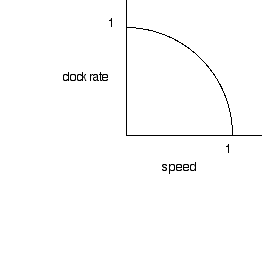
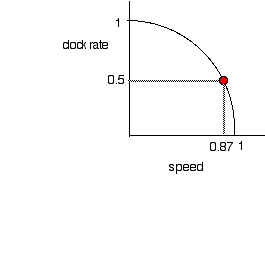
The world is not as it seems nor is it otherwise
Introduction
A century ago our understanding of space and time changed forever.
Before 1905 scientists used ideas of absolute space and absolute time that had been used by Isaac Newton. After 1905 scientists had to use the notion of space-time created by Albert Einstein.
Join us as we explore space-time in an Exploratorium way.
We'll look at experiments, do thought experiments, and play with spacetime to get a feel for what's going on.
Exploring Time
In our everyday experience clocks measure time, and time is absolute, it doesn't matter where the clock is or whether it is moving or not it seems to tick off time at the same rate.
Compare watches with a friend as you leave San Francisco on a round-the-world tour by jet. When you return you compare watches again, They will agree to within the accuracy of the watches.So it seems that Newtons idea that clocks run at the same at all speeds and in all llocations is correct.
However this very experiment was done in 1971 using very accurate atomic clocks (cesium beam) flying around the world strapped to the wall in coach class in a 707 airliner.
In 40 hours of flying at 550 miles per hour the flying clock ran slower and measured less time than the clock on the ground.
calculation g = 1/(1-v^2/c^2)^0.5 with v = 550 and c = 700,000,000g = 1+ 3 * 10^-13
40 hrs = 1.5 * 10^5 s so it takes longer by 4.5 * 10 ^-8 s or 45 nanoseconds.
Atomic clocks can easily measure this time difference.
Calculator to do this? ala RonH your weight on other worlds. Slow speed calculator, high speed calculator. metric english.
Einstein realized in 1905 that our everyday experience was an approximation that was pretty good at slow speeds but which became obviously wrong for clocks that were moving.
In Einstein's view a watch connected to you always seems to run at the same rate no matter where you are or how fast you are going, but when the watch is moving relative to you that it seems to run at a slower rate.
He also realized that when the length of a moving object was measured, the length along the direction of motion was shorter than when the object was measured at rest.
The combination of the shorter distance in a shorter time kept the speed of light the same in all reference frames, at all speeds and in all locations.
So in special relativity space and time are no
longer absolute but the speed of light is.
Trading speed through space for speed through time
In special relativity there is a relationship between speed and clock rate.
Speed through space changes the rate of a clock..
A high speed clock runs slower than a clock at rest.
The relationship can be shown by drawing a circular arc connecting one axis that shows speed and a perpendicular axis that shows clock rate.
If you choose a speed along the x-axis, then the arc willl show you the rate at which a clock moving at that speed runs relative to you.
For example if you travel at a speed of 0.87 (on a scale where the speed of light is 1) Then the circle shows that your clock runs at 0.5, half speed.


Clock rate versus speed always falls on a circular
arc.
The faster a clock moves through space the slower it goes through
time.
Trading east for north
Consider a car travelling across the desert, the car is on cruise control at 100 km/hr (about 60 mph)
Point the car east and you can cover 100 km to the east in one hour,
Point it north and you can cover 100 km to the north in one hour.
Point it northeast and you can cover 71 km to the east and 71 km to the north,
Steer a little south of northeast and you can go a little further east at the expense of going a little less far north.
It's a sum game with the trade off of east for north given by drawing a circle of radius 100 km.
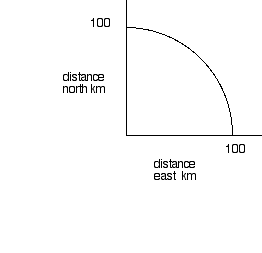
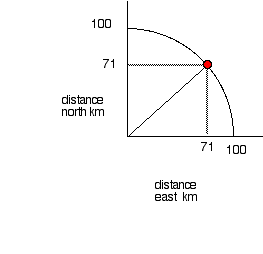
The speed of light
The speed of light is defined to be exactly: c= 2.99792458 x 10^8 m/s
or about 3 * 10^8 m/s or
186,000 miles per second.
or 700,000,000 miles per hour
Originally, scientists defined a standard for the second which started as a pendulum clock and which recently became an atomic maser clock.
Scientists also defined a length which was the distance between two scratches on a platinum-iridium bar. However, scientists have now re-defined the meter in terms of the distance light travels during a given time. The time is defined by an atomic clock.
So we have gone from a system in which we defined length and time and measured the speed of light to one in which we have defined a time interval and the speed of light and derived a distance.
In Einsteins theory of special relativity one of the fundamental postulates is that the speed of light in a vacuum is the same in all reference frames which move in a straight line at a constant velocity.
The speed of light is independent of frequency, Bradley Schaefer of Yale.
The speed of light, c, equals 1 when measured in the correct units. If distance is measured in light-years and time is measured in years then c = 1 light year per year = 1.
Light speed is also 1 if distance is measured in light seconds and time in seconds, c = 1 lightsecond per second.
It's harder to measure the length of a flying carpet than it is to measure the length of a carpet just lying on the floor.
To measure the length of a carpet on the floor, measure the position of one edge at any time then measure the position of the other edge at any time. If the carpet doesn't move then just subtract the two positions to get the length of the carpet.
For example one edge of the carpet is at x = 0 feet at time 0, and the other edge is at x = 12 feet at time 10 seconds, so the carpet is 12 feet long.
To measure a flying carpet you have to make sure you measure the location of the front of the carpet and the back of the carpet at the same time.
Consider a carpet moving forward at 10 feet per second, if you measure the position of the back of the capet at 0 feet at time 0 then measure the position of the front of the carpet at 112 feet at t= 10 s then you cannnot find the length of the carpet by simple subtraction. The carpet is not 112 feet long. It has moved 100 feet and is 12 feet long.
The problem is that two different observers moving at different speeds do not agree on when two events are simultaneous if they happen at different positions. If I'm flying with the carpet and measure that the rear of the carpet is at 0 feet at time 0 and that the front is at 12 feet at time zero. A person who sees that the carpet and I are moving would say no you made a mistake, you measured the position of the rear of the carpet at one time, time zero but you measured the position of the front of the carpet at a later time so the carpet is actually shorter than 12 feet. For example if you are flying the carpet at 0.87 the speed of light then the observer would say that the carpet was only 6 feet long and moved 6 feet between your measurements.
Plot the length of the carpet versus speed.
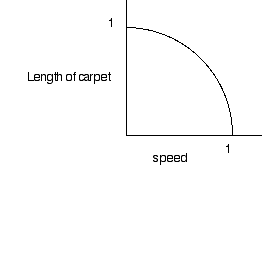
Here is a plot of the relative length of an object versus its length when measured at rest as a function of speed.
Have a rabbit carrying a clock move a distance of one light second in one second measured by an observers clock. (arm holding a clock in the foreground.) The observer clock is in the middle of the rabbit's run. The rabbit clock is stopped.
At slower speeds the rabbit's clock runs, but it runs more slowly.
Time passage during journeys at speed.
You enter the length of the journey measured on your clock and the speed of the journey in your frame of reference and the calculatorn shows the time that passes in the frame of reference of the moving object.
Examples of time changes
Muon movie showing muon clock running slow as viewed from earth and the earth's atmosphere shortened from the muon point of view.
jet flight, 1971 707
satellite GPS
in your television
At SLAC
clock array image idea
2-D black space (with an option for 3-D ala "Time Bandits")
An array of clocks all running together.
A moving clock that loses time becuase it is moving.
Relativity Poems
Limericks
There once was a fencer named fisk
whose thrust was exceedingly brisk
so fast was his action
tyhe lorentz contraction
shortened his rapier to a disk
Ther once was a lady named bright
who could travel much faster than light
she departed one day
in a relative way
and returned the previous night.
Big interesting ideas of special relativity
Clocks run slow in moving frames
lengths are shortened in the direction of motion
the speed of light is the same in all moving frames
relativistic velocity addition
E = mc^2
Time and space are intertwined as spacetime via the Lorentz transformation.
The nobel prize site has a good start at a relativity
page.
Mostly stills with a little animation.
We could do better.
Atomic clock
The new miniature clock has a precision of 3.5 x 10^-10. What this means is that events can be timed with an uncertainty of about one part in 3 billion. Scientists at NIST in Boulder, Colorado make atomic clocks that are far more precise---the F-1 clock is good to about one part in 10 trillion, 10^13---but this requires a huge table-top's worth of equipment. The mini version being reported now should eventually reach a stability of about 10^-11, some 10,000 times better than any quartz oscillator clock of equivalent size and power.
|
Scientific Explorations with Paul Doherty |
|
15 April 2005 |